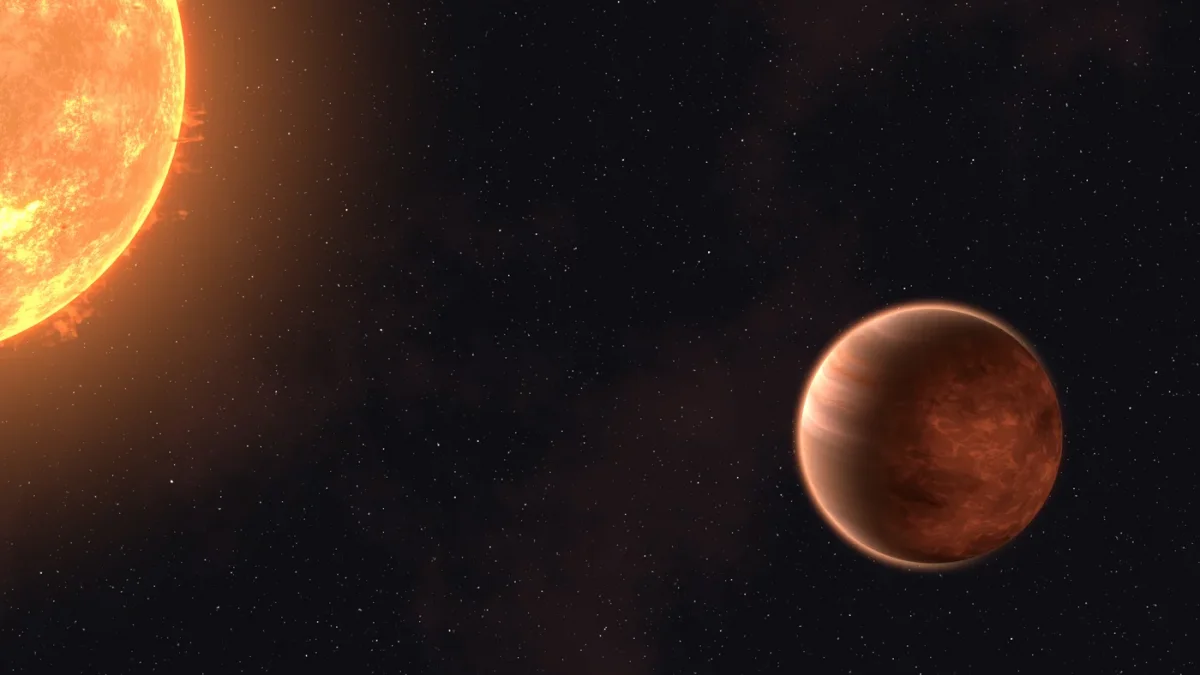Exoplanet LP 890-9c may contain liquid water, but it may also be an uninhabitable Venus. The research team wants to examine it more closely.
Ithaca – Not all rocky planets are alike, as can already be seen in our solar system: Venus and Earth – although very similar – have evolved very differently. Venus is a scorching inferno with a closed cloud cover composed largely of sulfuric acid and a surface pressure 90 times higher than Earth’s. The strong greenhouse effect makes the planet uninhabitable. In contrast, nearly three-quarters of Earth’s surface is covered in water, and temperatures are mostly comfortable—the planet is habitable and teeming with life.
How could the two rocky planets evolve in different directions? A research team headed by Austrian astronomer Lisa Kaltenegger, who conducts research at Cornell University in Ithaca (USA), is asking this question. The team has found the perfect celestial body to study the question: exoplanet LP 890-9c was discovered in 2022 by a team including Kaltenegger. It is about 40% larger than Earth (which makes it called a “super-Earth”), is about 105 light-years distant, and orbits its star once every 8.5 days.
Why did Venus and Earth develop differently? Exoplanet LP 890-9c is ‘key’
Once an exoplanet was discovered, it was suspected that there might be water on its surface. Although the star orbits close to its planet, it still receives little stellar radiation, which could allow liquid water to exist on the surface if it had an atmosphere. This fact makes the exoplanet “key in the question of how Venus and Earth could have evolved so differently,” Kaltenegger’s research team wrote in the study. in the journal Monthly Notices of the Royal Astronomical Society: Letters published had become.

“In the inner part of the habitable zone, we expect hot, habitable planets. But when does it get too hot? We have models that predict how close a planet will be to its star before it gets too hot. But we’ve never observed such planets,” Kaltenegger explains. when asked FR.de from IPPEN. MEDIA. This is why exoplanet LP 890-9c is so exciting: It lies right on the border of the habitable zone – the region around a star in which liquid water might be possible on a planet’s surface.
ABOUT IPPEN. MEDIA
the IPPEN. MEDIANetzwerk is one of the largest online publishers in Germany. At locations in Berlin, Hamburg/Bremen, Munich, Frankfurt, Cologne, Stuttgart and Vienna, journalists from our central editorial office research and publish for more than 50 news shows. These include brands such as Münchner Merkur, Frankfurter Rundschau and BuzzFeed Germany. Our news, interviews, analysis and commentary reach more than 5 million people in Germany every day.
How long does a rocky planet remain habitable at the inner edge of the habitable zone?
For the study, the research team created seven different models of LP 890-9c’s planetary atmosphere. Kaltenegger explains the study’s approach in one: “Looking at this planet will show us what happens at the inner edge of the habitable zone — how long a rocky planet can remain habitable once it starts to rise.” Notice from your university. “It will teach us something fundamental about how rocky planets evolve as starlight increases and what will one day happen to us and our Earth.”
The Austrian astronomer points to the fact that the Sun gets brighter with age — until it gets so hot on Earth in about 500 to 800 million years that the oceans evaporate. “This is exactly where the LP 890-9c’s notes get exciting,” says Kaltenegger. If the exoplanet is indeed an “uninhabitable planet,” it could be faster than expected and only have 500 million years left. On the other hand, if the exoplanet is still a living, hot Earth, then there is more time left on our Earth. “Because this planet gets – relatively speaking – more light from its star than we do from the Sun, it gives us a glimpse into a possible future.”
The James Webb Space Telescope can detect the atmosphere of an exoplanet
Also in a second study in the journal Monthly Notices of the Royal Astronomical Society: Letters published Caltenegger and Jonathan Gomez-Barrientos (Caltech) are investigating whether and how the James Webb Space Telescope (JWST) can study exoplanets LP 890-9c. “Professor Kaltenegger and I thought this exoplanet could be an excellent target for a JWST,” says Barrientos. The study shows that the new space telescope is able to confirm the presence of a possible atmosphere.
“Using the James Webb Space Telescope, for the first time we have a telescope large enough to study rocky planets and see if LP 890-9c is still a living, hot Earth or a planet where all the water has evaporated and is still trapped in the atmosphere – or the planet has already lost all of its water and has become Venus We often learn the most new things within our understanding, ”Kaltenegger emphasizes. Therefore, the astronomer also wants to try to obtain the time of the JWST observation of an exoplanet.
Exoplanet LP 890-9c could also look like Venus
If the Earth telescope spots an exoplanet three times as it passes in front of its star (a so-called transit), the telescope can already show whether its atmosphere is largely composed of water vapor. After eight transits, JWST can detect Venus’s like atmosphere, and after 20 transits, the telescope can also find evidence of a possible hot but habitable Earth scenario, the research team noted.
Using the James Webb Space Telescope, for the first time we have a telescope large enough to study rocky planets and see if LP 890-9c is still a living, hot Earth or a planet where all the water has already evaporated and was trapped in the atmosphere – or the planet has already lost all of its water and has become a planet. Flower. We often learn the most new things within our understanding.
However, it is still possible that the exoplanet LP 890-9c has no atmosphere and no life on it. It could also resemble Venus, with thick clouds that create a greenhouse effect and allow little information to leak out. “We don’t know how this planet could be on the brink of habitability, so we have to look,” Kaltenegger points out. “This is what real research is about.” (unpaid bill)

“Tv expert. Hardcore creator. Extreme music fan. Lifelong twitter geek. Certified travel enthusiast. Baconaholic. Pop culture nerd. Reader. Freelance student.”







More Stories
Exoplanet WASP-43b: Clouds of liquid rock, but surprisingly methane-free
Extremism: Chairman Verdi: There is no place for people who hold positions in the AfD
Mysterious methane on Mars: NASA has a new theory